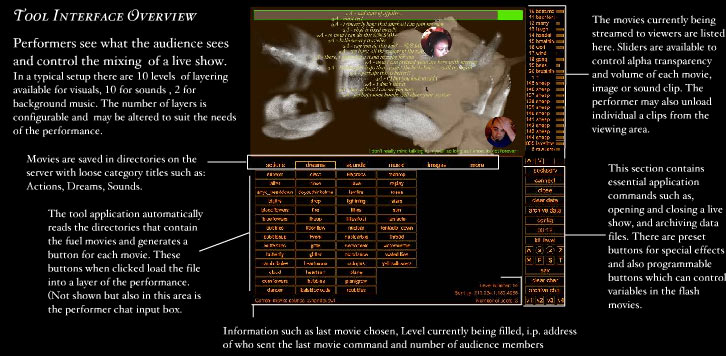
STILL IMAGE FROM WIREFIRE PERFORMANCE.
Wirefire is an online performance, a communications environment and a very good story.
This project utilizes technology we have developed to touch through the wires that combines chat, sounds, images, animations and live camera streams to form an interactive, improvisational expression which goes beyond words.
We create simple files which are mixed in real time. Built in is a sytem for us to see the presence of viewers and also a way for the audience to communicate with the performers. The system exists entirely on the Internet meaning that we can be in any location and the performance can be viewed by anyone with a current web browser and the Flash 5 plug-in. This is the only online performance/tool of its kind which we have been operating since July 1999 and in its present format since April 2001.
We are LIVE online inside the Wirefire environment every Thursday night from Midnight to Friday 1am ( Belgian time) Wirefire is meant to be performed and viewed online but we have given non-virtual Wirefire performances in venues such as the Brooklyn Academy of Music and the Walker Arts Center. Wirefire has been presented in locations such as the GMI screen in London and Passage44 in Brussels.
Wirefire is our personal remixer of emotions and graphics, it provides an opportunity to free-associate the themes and materials in our work and an opportunity to infect our collaboration with Autopoëzie.
-
Wirefire may be viewed in three distinctly different modes.
- Random mode: In this mode just sit back and let the computers do the work mixing files at random from our library of Wirefire material. When we start a performance Random automatically switches into Live mode.
- Live mode: when the humans take control. This mode allows for real time image blend effects and sound mixing . During the perfomances one can see how many are "in the audience" as the presence of each viewer connected is shown as a small spec of dust on your screen. You can be aware of who is at the controls by live webcamera images and text chats between performers and between audience members. All of these elements make for quite a different experience of the Wirefire environment than the Replay or Random versions.
- Replay mode: if you have missed one of our live performances you can come to the site and view it in Replay mode. After every performance a data file is saved and the entire show can be replayed from the server. While the files are shown in the same order the timing is random, and it is archived without chat, live images and none of the realtime effects produced during the Live show.
Wirefire is a meeting of two minds. Michael had an idea of how to make a theatrical entertainment environment where people could connect remotely and act out their fantasies. Auriea, an exhibitionist and performance artist wanted to make an online event which could serve as communication and creative excercise. Both of us with a strong desire to get out of the box and say... show... what we really mean.
This project evolved, most importantly, however, from our earliest forms of communication through the internet. We met each other online and that was for a long time the only means we had to communicate with one another. We used commercially available video chat software but quickly felt its limitations. It had live images and some audio capabilities but left us feeling as if a barrier were between us, a gulf of space and time clouding our feelings. It lacked a way for us to collaborate on our various projects and it lacked feeling.
We graduated to creating our own online "office" which afforded us a place to meet online. Javascript clocks were set up which told us the time in our respective locations: New York City, USA, and Ronse, Belgium. We put in a cgi based chat and organized html pages linked to our current work and important links. We became chat addicts and addicted to each other. Meeting in secret in our private place. Joining forces to make magic online. During our time in that interface we noticed how HTML could be input into the text chat to change things like colors and font sizes. As time went on the interface developed into a way to play music for each other and leave love notes.
The sea of frustration which engulfed us during this time raised many issues about what it means to interact with another human using digital media. We created another project titled skinonskinonskin which dealt with our everyday lives and the complications of this new relationship between us in contrast to the intensity of our online correspondance. This is the main current which runs through Wirefire... what does one do when you fall in love with a 160x120 pixel image? How is it to be a digital being in love? What is ecstacy like in the network?
Once we came together in the same location we decided to take what we had learned from our office and the emotional lessons of skinonskinonskin and develop it into something which would be an effective system for our communications while on the road and for public entertainments.


